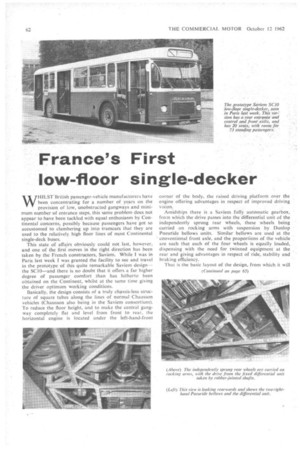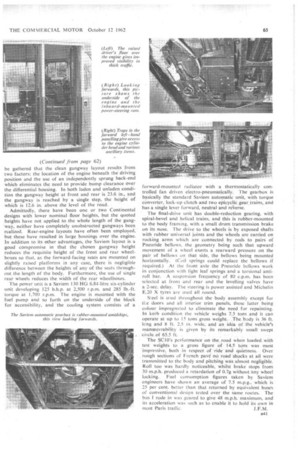France's First low-floor single-decker
Page 64

Page 67

If you've noticed an error in this article please click here to report it so we can fix it.
WHILST-British passenger-vehicle manufacturers have been concentrating for a number of years on the provision of low, unobstructed gangways and minimum number of entrance steps, this same problem does not appear to have been tackled with equal enthusiasm by Continental concerns, possibly because passengers have got so accustomed to clambering up into tramcars that they are used to the relatively high floor lines of most Continental single-deck buses.
This state of affairs obviously could not last, however, and one of the firs( moves in the right direction has been taken by constructors, Saviem. While I was in Paris last week I was granted the facility to see and travel in the prototype of this quite remarkable Saviem design— the SCIO—and there is no doubt that it offers a far higher degree of passenger comfort than has hitherto been obtained on the Continent, whilst at the same time giving the driver optimum working conditions.
Basically, the design consists of a truly chassis-less structure of square tubes along the lines of normal -ChausSon vehicles (Chausson also being in the Saviem consortium). To reduce the floor height, and to make the central gangway completely. flat and level from front to rear, the horizontal engine is located under the left-hand-front
corner of the body, the raised driving platform over the engine offering advantages in respect of improved driving vision.
Amidships there is a Saviem fully automatic gearbox, from_ which the drive passes into the differentialunit of the independently sprung rear wheels, these wheels being carried on rockingarms with suspension by Dunlop Pneuride bellows units. Similar bellows are used at the conventional front axle, and the proportions of the vehicle are such that each of the four wheels is equally loaded, dispensing with the need for twinned equipment at the rear and giving advantages in respect of ride, stability and braking efficiency.
That is the basic layout of the design, from which it will (Coiiiiimed on page 65)
be gathered that the clean gangway layout ,results from two factors: the location of the engine beneath the driving position and the use of an independently sprung back-end which eliminates the need to provide bump clearance over the differential housing. In both laden and unladen condition the gangway height at front and rear is 23.6 in., and the gangway is reached by a single step, the height of which is 12.6 in. above the level of the road.
Adrnittedly, there have been one or two Continental designs with lower nominal floor heights, but the quoted heights have not applied to the whole length of the gangVair, neither have completely unobstructed gangways been realized. Rear-engine layouts have often been employed, but these have resulted in large housings over the engine. In addition to its other advantages, the Saviem layout is a good compromise in that the chosen gangway height reduces the requisite height of the front and rear wheelboxes so that, as the forward-facing seats are mounted on slightly raised platforms in any case, there is negligible difference between the heights of any of the seats throughout. the length of the body. Furthermore, the use of single rear wheels reduces the width of the rear wheelboxes.
The power unit is a Saviem 130 HG 6.84-litre six-cylinder unit developing 125 b.h.p. at 2,500 r.p.m. and 285 lb.-ft. torque at 1,700 r.p.m. The engine is mounted with the fuel pump and so forth on the underside of the block for accessibility, and the cooling system consists of a forward-mounted radiator with a thermostatically controlled fan driven electro-pneumatically.. The gearbox is basically the standard Saviem automatic unit, with torque converter, lock-up clutch arid two epicyclic gearjrains,,and has a single lever forward, neutral and reverse. •
The final-drive unit has double-reduction gearing, with spiral-bevel and helical trains, and this is rubber-mounted to the body framing, with a small drum transmission brake on its nose. The drive to the wheels is by exposed shafts with rubber universal joints and the wheels are carried on rocking arms which are connected by rods to pairs. of Pneuride bellows, the geometry being such that upward movement of a wheel exerts a rearward pressure on the pair of bellows on that side, the bellows being mounted horizontally. (Coil springs could replace the bellows if required.) At the front axle the Pneuride bellows work in conjunction with light leaf springs and a torsional antiroll bar. A suspension frequency of 80 c.p.m. has been selected at front and rear and the levelling valves have a 2-sec. delay. The steering is power assisted and Michelin E.20 X tyres are used all round.
Steel is used throughout the body assembly except for tl:e doors and all interior trim panels, these 'latter being colour impregnated to eliminate the need for repainting. In kerb condition the vehicle weighs 7.5 tons and it can operate at up to 15 tons gross weight. The.. body is 36 ft. long and 8 ft. 2.5 in wide, and an idea of the vehicle's maneeuvrability is given by its remarkablysmall swept
circle..of 65.5: ft. • •
The SCIO's performance on the.road when loaded..with test *eights to a gross figure 'of 14.5 .itOns was most impressive, both in respect. Of -ride' and quietness. . Over rough sections of French pave 41O:roa&Sh.bet.s.at ad Were transmitted to the body and pitching was almost Roll too was hardly noticeable, -whilst brake stops from 30'rn.p.h. produced a retardation of 0.7g without any wheel locking. Fuel consumption figures taken by Saviem engineers have shown an average of 7.5 m.p.g., which is 25 per cent, better than that returned by equivalent buses of conventional design tested over the same routes. The bus I rode in was geared to give 48 m.p.h. maximum, and its acceleration was such as to enable it to hold its own in
most Paris traffic. J.F.M.




















































































































